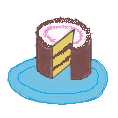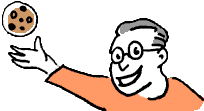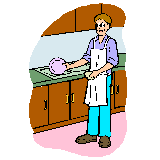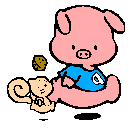
- constant frontal headache
- stiff neck and pain radiates from between her neck to between her shoulder blades
- pain in dorsum of forearms & altered sensation in fingertips
- limitations in neck flexion, side flexion & rotation
- tightness of upper cervical extensors, pecs, & scaleni & rhomboid weakness
- paraspinal muscle spasm (> on L side)
- generalized weakness on L upper extremity median nerve distribution
Previous Roles & Responsibilities
- mother (has 2 young children)
- wife (husband frequently out of town)
- responsible for all of homemaking & child rearing tasks
- responsible for looking after husbandís books on computer
- DATS driver
Assumptions
- right handed
- client expressed an interest in cooking
- being able to cook & take care of family is an important goal / routine in her life
- deconditioned due to 8 months of broken routine
- also poor balance of ADL incl, self care, productivity, leisure
- problems with "pacing" and either too little activity or too much (suffers consequences later)

Goals
1) empower client such that she can take control of her pain (& her life), as opposed to pain controlling her life
2) body awareness (awareness of limits) & pacing
3) return to roles & routines
4) increased ROM and stamina
5) rearrange / adapt environment
6) good body mechanics
Adaptive Equipment
- Swivel book holder with movable arm (to hold papers / recipes)
- Arm support (designed to prevent arm, shoulder, and neck fatigue)
Procedure
Step 1
- look at kitchen ergonomics
- avoid excessive reaching & bending
- physically analyzed recipes on computer
- client chooses recipe she feels is up to her level physically
- this gives indication of performance areas client is having problems with
- plan activity
- discuss physical demands
- plan breaks such that she does not strain herself
- test limitations in terms of body mechanics
Step 4
- do the activity independently
Step 5
- journal
- client keeps a journal, indicating how she felt physically while doing the activity, problems, how satisfied she was, how she felt she could have been more effective, and if she felt she had overexerted herself.
 Therapeutic Benefit
Therapeutic Benefit- this is age-appropriate & culturally significant activity
- in her role as a homemaker, cooking is an activity that is important for her and gives her a sense of accomplishment in re-establishing her normal routines
- challenging physically and can be graded
- helps increase ROM & stamina in neck through the activies of chopping, grating, and reading recipes. The height of the cutting surface and recipe holder can be adjusted as client becomes more comfortable with various degrees of flexion in her neck

- manually washing the dishes after cooking will help her increase the ROM in her neck with respect to side to side flexion. She can begin with short time intervals (i.e. wash 3 dishes and place in dish rack) and increase the time intervals as she feels more comfortable
- learning to adjust to her environment by ergonomically re-arranging kitchen and learning appropriate body mechanics
- because recipes are on computer, she can slowly become used to using the computer which will be adapted to meet her physical deficits
- with time, she an increase the period of time that she spends on the computer
- learn skills for analyzing activities in her life in order to anticipate and gain control over the amount of pain she experiences
Grading
1. Stamina and ROM
- can be graded with respect to difficulty, length of time for preparation, amount of neck flexion required for individual recipe
- because there are physically analyzed recipes, she can begin with the less demanding ones in order to get used to the use of proper body mechanics
- she can also test her limits and gain confidence in her abilities by beginning with less demanding activities
- with time, she can move on to more challenging recipes that require more ROM and stamina
- through the use of a journal, the client and therapist can keep track of improvements in physical function
- clientís increasing feelings of control will be apparent to therapist as the client first independently chooses recipes from those previously analyzed by the therapist which she feels is appropriate to her level (with respect to physical demands, time required for preparation, and scheduling breaks)
- when client feels ready, she then chooses unanalyzed recipes from other sources (cookbooks, internet) and analyzes the physical requirements with the help of the therapist
- finally client is able to analyze recipes herself and gain confidence in her ability to analyze other activities in her life thereby not unnecessarily restricting her occupational performance

